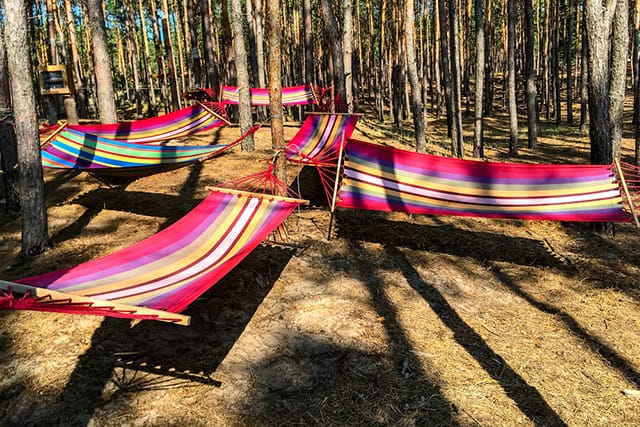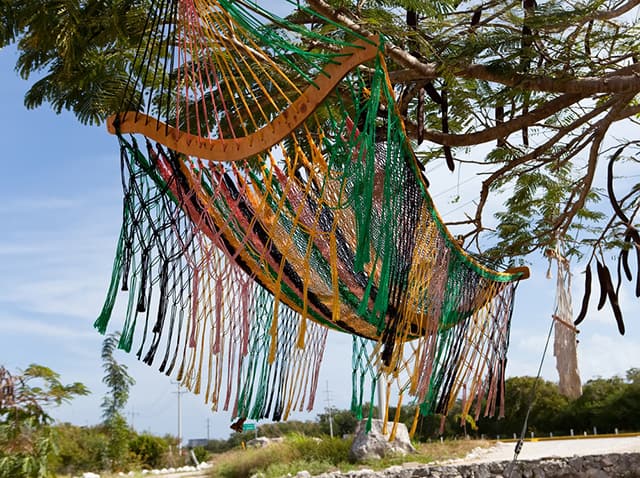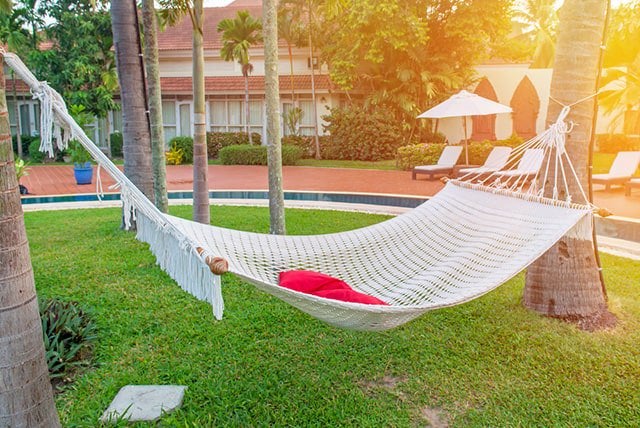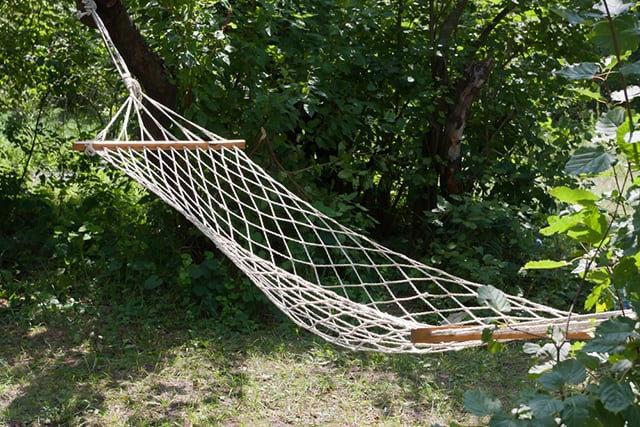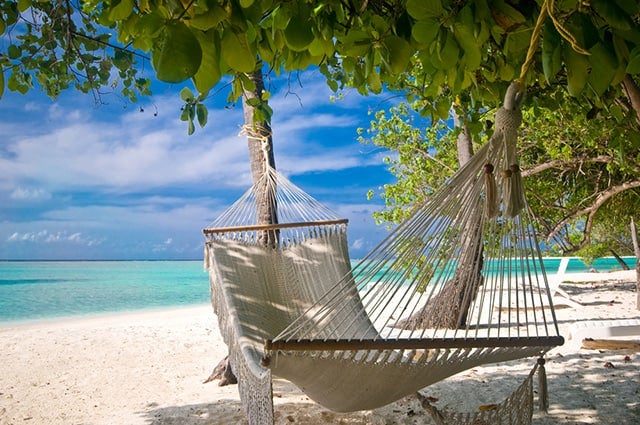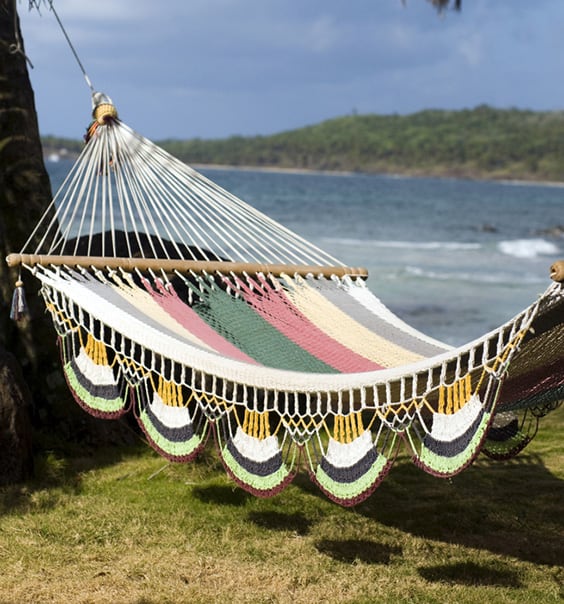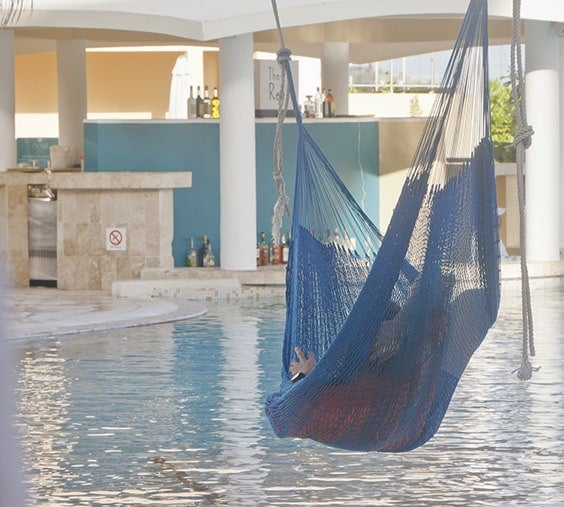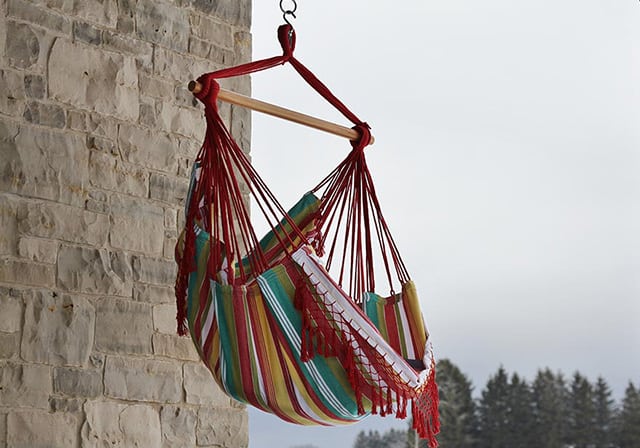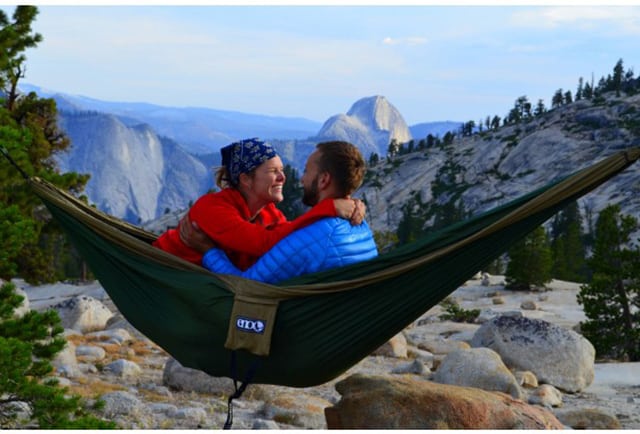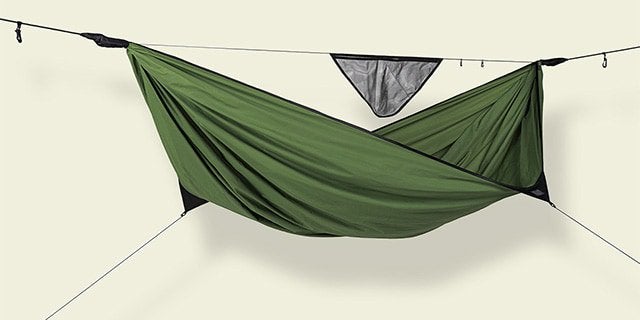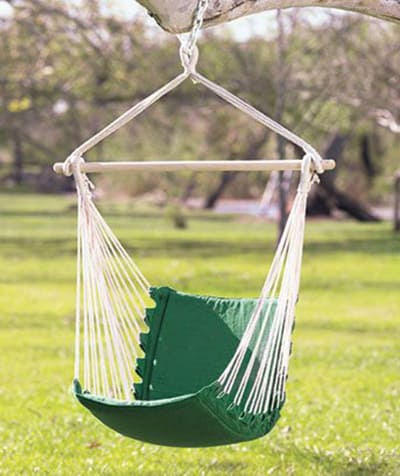Few things are as comforting in life as the simplicity of the hammock. Whether besides the beach, on a lake or simply in your backyard, the hammock provides a level relaxation few things can match. There is also an added level of customization with hammocks, which you may or may not realize.
For instance, were you aware there are multiple types of hammocks? There are different types of fabrics which provide different levels of comfort and strength, for instance. Some are made to stand alone, while others need some sort of existing support.
Finding the correct hammock isn’t difficult, as any hammock is going to give you a great level of comfort, but learning about all of your options is a great way to be sure you’re getting exactly what you need.
What is a Hammock?
Let’s start off plainly: A hammock is a piece of fabric or netting which has been suspended between two points with rope, chain or some other type of strong material. In modern days, hammocks are typically used for relaxation, but over the years they have been used for sleep, among other things. In fact, their use may often depend on which part of the world they are being used.
Who Created the Hammock?
This question is basically impossible to answer, but it is known that the hammock has existed in the Americas for a very long time. One of the first Europeans to make note of the hammock was Christopher Columbus, of all people. During his first visit to the continent, Columbus wrote about the Native Americans bringing items to the boat for trade. In his notes, he wrote that they came to the ship in hopes of “bartering their cotton, and hamacas, or nets, in which they sleep.”
El Salvador
Other cultures also have a long-standing tradition of using the hammock. In El Salvador, hammocks were used by the natives as a way to keep their sleep protected from earthquakes. In time, they have become a part of the culture, not bound to any single social class. Napping is perfectly acceptable in a hammock. One part of the country even celebrates the hammock with its annual Hammocks Festival. If you’re visiting El Salvador, you best find a good hammock.
Mexico
Further north, the hammock becomes something truly special and historic. Many villages in the Yucatan create hammocks in a Mayan style, even though they weren’t really part of the Mayan culture. According to records, the hammock didn’t show up in the Mayan civilization until a hundred years or so before the conquistadors decided to invade.
When it comes to the Mayan hammock bed, things are fairly intense. Much as with a rug or other similar multi-fabric piece of material, the hammocks are made on a loom and are typically woven by hand. Threads are placed and run until the hammock is created.
In the culture, and the home, hammocks are a big deal. They may not hold a festival for hammocks in the Yucatan, but they do have hammocks all over the place, and especially in every home.
Venezuela
The Venezuelan or Brazilian style hammock is a work of art. When in a jungle, it’s necessary to take some precautions both for your safety and for your comfort, and the Venezuelan hammock keeps this in mind. Not only are you elevated above where all the creepy crawlies of the jungle floor like to live, you’re protected and made comfortable. In a hammock, you don’t have to worry so much about a scorpion getting its stinger into your arm.
Additionally, certain kinds of nettings were created to keep sleepers safe. Firstly, the hammock itself is made of a breathable material, allowing for good airflow and to keep humidity from building up and causing problems. A thin netting was also invented in order to keep mosquitos and the like away from the sleeper, which is important in areas in which they carry diseases.
This netting can be switched out quite quickly in the event it begins to rain, and the new layer would have “drip strings,” which are used to keep water from flowing down the tree trunk and into the hammock itself, negating the rainfly. One final, genius idea is a breathable bottom layer, keeping mosquitoes out while protecting the sleeper from too much humidity.
India
Though not the same as those seen in the Americas, the hammock did exist in one form in India. It was used, however, primarily for children. In the Indian traditional method, a Sari, which is a woven piece of cloth worn as a garment by Indian women, is hung from the ceiling. Into the Sari, a baby is typically placed, or any child up to the age of a toddler. This baby hammock concept helps to keep them cool in areas which are very hot and keeps them safe while they sleep.
Hammocks in the Modern Day
Many hammocks produced today still resemble the traditional hammocks of old, but they offer modern conveniences which make things both more comfortable and more functional. Different hammock styles are one thing, but the fact there are different types of hammocks makes things interesting, to say the least.
1. Rope Hammocks
Chances are when you first read the word “hammock” at the start of this article an image popped into your head. It was likely the rope net, lashed between two trees, waiting for someone to climb in and take a little nap. That would be the rope hammock. Typically, rope hammocks are made of either cotton or polyester ropes, and in order to keep the user from flipping too much, it includes a spreader bar at either end to help it keep its flat shape, rather than bunching up. Trust me, you don’t want a rope hammock without a spreader bar.
Of the two materials, cotton is considered more comfortable, but polyester is more durable. Polyester isn’t going to grow mold or mildew, whereas cotton can absorb the water, holding it in until it begins to cause problems. Since the main body of the fabric is made up of netting, a rope hammock isn’t a good family size hammock.
2. Quilted Hammocks
My personal favorite, at least in concept, is the quilted hammock. The quilted hammock is composed of two fabric layers stuffed with some sort of soft filling. Since it’s all cloth, these aren’t the best hammocks to use outdoors but are very comfortable. In fact, this might make for a good bedroom hammock, if that’s something you’re interested in. If you really want to go all in, a quilted hammock might even be your best bet for an indoor hammock bed.
Something to keep in mind, however, is that, though the quilted hammock may be soft, it isn’t going to be as flexible as, say, a Mayan hammock or any of its variations. For extended hammocking, the quilted hammock may not be the best, and you could be better off simply going with one of the other styles, but adding your own layer of softness through the use of either a thick blanket or a sleeping bag.
3. Mayan Hammocks
Hammocks made in the traditional Mayan style, as we talked about earlier, are of high value. Their construction allows them to hold large amounts of weight while being able to more easily conform to the curves of whoever is sleeping in them. And, since they don’t have a spreader bar, they’re very easy to transport. A couple of these would make for good camping hammocks. This is also helped by the fact they can be used in any type of weather, though they’ll last the longest if kept out of the elements. They may be good for travel, but they would also serve well among indoor hammocks for bedrooms.
4. Brazilian and Nicaraguan Hammocks
These two varieties bear a great many similarities to the Mayan hammock. They are constructed of multiple fibers on a loom, making them very solid and long-lasting. They also don’t include spreader bars, making them portable, though a few Brazilian models can be found with a spreader bar, should someone desire one. The Nicaraguan uses a special type of weave which makes it a little stronger and less likely to tear than something like the Mayan. Also as with the Mayan, either of these would make for a great indoor sleeping hammock.
5. Poolside Hammocks
If hopping onto a hammock after climbing out of the pool is in the cards for you, you should greatly consider getting a poolside hammock. Though it doesn’t have to be placed beside a pool, it is recommended. The fabric used to create the hammock is made to allow water to quickly move through it, not allowing it to build up and either keep you wet or encourage the growth of mildew. Plus, it’s a great way to add some visual interest to your backyard pool area, much like adding a nice decorative rug to an interior space.
Taking Care of Your Hammock
With each variety of hammock, it’s important to understand the best way to take care of yours. This doesn’t just include maintaining the look and comfort of your hammock but also making sure it has been hung in the proper fashion so as to avoid any risk of hurting yourself, your surroundings or your hammock.
Whether utilizing hammocks which need to be attached to something, or free standing hammocks, keeping in mind these things will have them lasting a good, long while. Most hammocks have the same sort of rules when hanging them from a wall: Make sure they’re secure. Where things can vary are in the differences in height.
Take, for instance, the Mayan hammock. In order to get the full effect of your hammock, you’re going to want to make sure the distance between the two hanging points is at least 12 feet, and it should be attached to something very solid, such as a stud with hooks if indoors, or fence posts or even a tree when outside. It should also be about six feet from the ground to allow for sinking.
The Brazilian hammock has a similar setup, which shouldn’t be surprising when considering the other similarities they have with the Mayan hammock.
Mounting Your Hammock
There are a number of ways out there to get your hammock into the air. You can screw hooks into posts, trees, wall studs and more, but there are also some less permanent and damaging options. When hanging a hammock onto a tree, for instance, one can use straps which wrap around branches, giving you a great grip but without causing damage to the tree.
In addition to hanging your hammock, you can also make use of a stand, or purchase any one of a number of self standing hammocks. An addition to causing damage to your home or yard, these hammocks are easy to set up and can be moved pretty much anywhere with ease. On a sunny day, they can be dragged into the light. Once the clouds roll in, the hammock can be pulled onto the porch, safe from the rain.
The key to safe mounting is making sure you have the right amount of room for your hammock, and that whatever you’re attaching it to can handle the weight. Typically, all of this information can be found in the documentation which came with your hammock, so be sure to take a look at it and read it thoroughly.
Should you intend to mount your hammock to posts in the ground, there are a couple things to consider. For strength purposes, the posts should be either metal or wood, and they should be buried at least 1.5 to 2 feet into the ground, then secured using cement. Doing this will make sure whoever is on the hammock won’t be pulling the posts out of the ground once they lay down on the thing.
Knowing Your Brands
Sure, you can find a hammock at pretty much any store which sells home products, but are they the best? That’s certainly a matter of opinion, but I can say there are a couple companies out there which offer unique options you can use to tailor-fit your hammock to your lifestyle.
A Vivere hammock, for instance, is elegant. Whether sold on its own or with one of the company’s beautiful wooden stands, the products come in multiple styles and colors, while looking very elegant. They also offer different varieties of hammocks, including quilted, poolside and Brazilian, among others.
Read our full review of the Vivere Hammock here.
On the other hand, Eagles Nest Outfitters, also known as ENO hammocks, has created a variety of parachute hammocks they feel will suit pretty much anyone out there. Unlike other fabric hammocks, the parachute hammock uses a nylon fabric in its construction, giving it strength, though perhaps sacrificing comfort a little. That, of course, remains to be seen.
My vote for best hammock store would have to go to Hennessy. The different types of Hennessy hammocks are wild, and they let you customize to your heart’s content. The base hammock type is a jungle hammock, which means it’s designed to keep you safe from bugs and the elements while keeping your cool and comfortable. That also means a Hennessy hammock is an outdoor hammock, one meant to be taken on long trips through dangerous terrain.
You can customize these hammocks to be fully enclosed, almost as though you were sleeping in a floating tent, which sounds like a lot of fun, to me. I could very easily see myself purchasing one of these for my back yard for a couple of cool nights under the stars.
Special Hammocks
One of the biggest issues people have with hammocks is getting into them. Climbing into a hammock can be a lesson in patience, and a true test of what someone’s limits are. The trick is to sit down on the edge of the hammock, then lay back. If that doesn’t work for you, maybe removing the laying back option would help, such as with a hammock chair.
Hammock chairs are an interesting option for those who want the sensation of floating without having to lie down. Typically, they only need a single point in a ceiling to be attached and can be quite comfortable.
Other types of unique or specialized hammocks also exist, some of which I don’t think I would ever have the courage to try. I have seen on more than one occasion giant nets used as hammocks. Nets similar to that one might see beneath a trapeze artist in the circus. These are large and can hold multiple people, making them great for a backyard setting for multiple family members.
Others still are designed for security. Not in the sense of keeping things from being stolen, but in the sense of keeping your body secure. Rock climbers sometimes use special hammocks to sleep on the side of a cliff face they are climbing, should they need a break. As someone with an extreme fear of heights, this isn’t something I would ever do, but I imagine the views are positively breathtaking. I’m guessing they have to be careful not to get up and make their way to the bathroom in the middle of the night.
Getting the Most Out of Your Hammock
In order to truly enjoy your hammock and avoid any possible negative side effects, such as aches and pains, a few tips should be kept in mind. Whether common sense or not, these are the suggested ways to make sure your relaxation is top notch.
Tip 1 :
The proper hang could be the most important thing of all. If your hammock is too taught, you’ll find yourself being unable to lay in it properly, and you’ll find it won’t conform to you in the way it should. Keep things loose and make sure there’s a fair amount of curvature to your hammock when it’s empty.
Tip 2:
Secondly, don’t forget the extras. You may not think you need a pillow, but if you use a pillow in bed, you’ll want to use a pillow in your hammock. You’ll also likely want something to cover yourself, whether that be a blanket or a sleeping bag.
Tip 3:
Your angle is quite important, as well. When looking at a hammock, it’s easy to see where your head and feet should be placed. There’s a fair chance, however, that you are wrong. You don’t want to lay parallel to the hammock. You actually want to lay out diagonally so you can stretch out and expand the hammock, giving yourself a great amount of room.
Since hammocks are designed to allow for good airflow, especially those created in any of the Central or South American styles, it’s easy to get cold. Utilizing a sleeping bag or blanket to wrap yourself up keeps you warm while also protecting you from any bugs and from any damage which may be caused to your skin due to rubbing on the hammock strings.
Tip 4:
Finally, you’ll want to figure out your best position. Starting out diagonally is good, as is using your pillow and wrapping yourself up, but don’t be afraid to move around in your little cocoon and figure out what works best for you. Really stretch out and make your sleeping experience unique to you.
You may be interested in: How to Find the Best Hammock Chair
Living the Hammock Life
Whether you’re hanging out seaside, relaxing on your back porch or trading in your bed for a hammock, these wonders of human ingenuity are truly awesome. A hammock is lightweight enough to take anywhere, strong enough to hold most anyone and comfortable enough to use every day of the week.
Considering all of the options and picking out the perfect hammock isn’t hard. For many situations, one of the Central American hammocks is going to do well for you, but there’s nothing wrong with the more traditional rope hammock, should that be your preferred style.
All that really matters is finding the best way for you to lay back, kick off your shoes and enjoy a little time to yourself. Hammocks are great places to read a book, listen to music, enjoy nature or simply sleep the night away.


